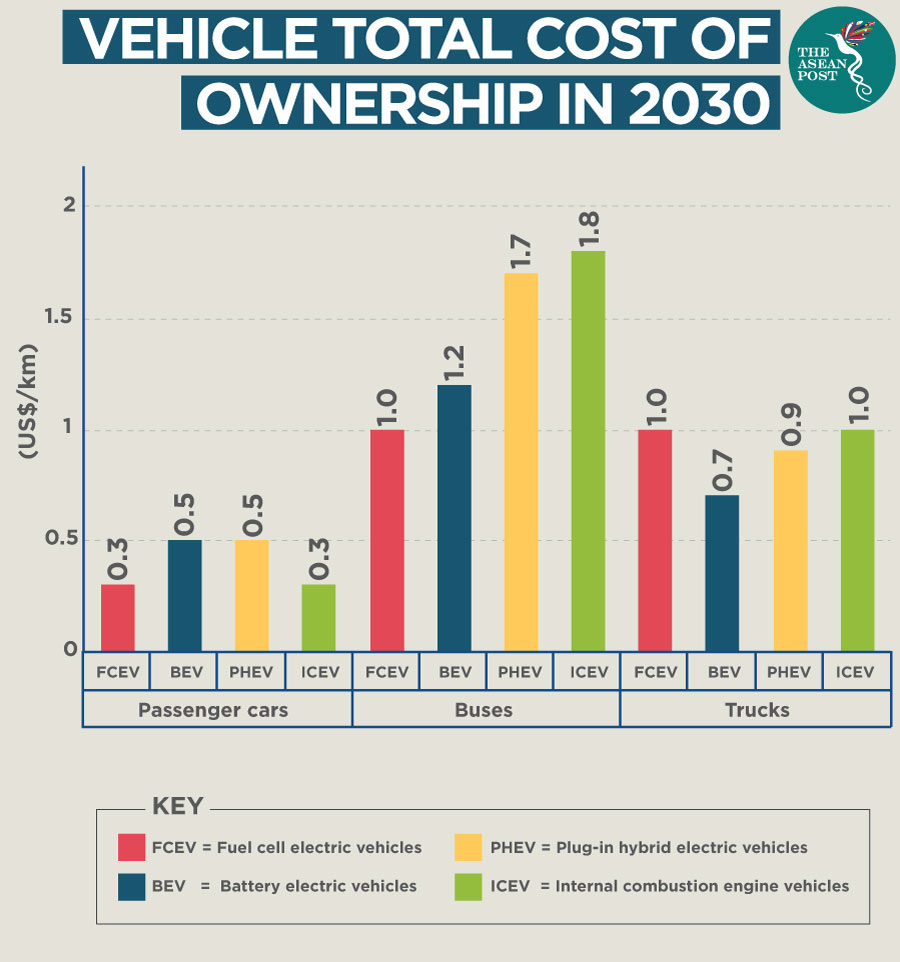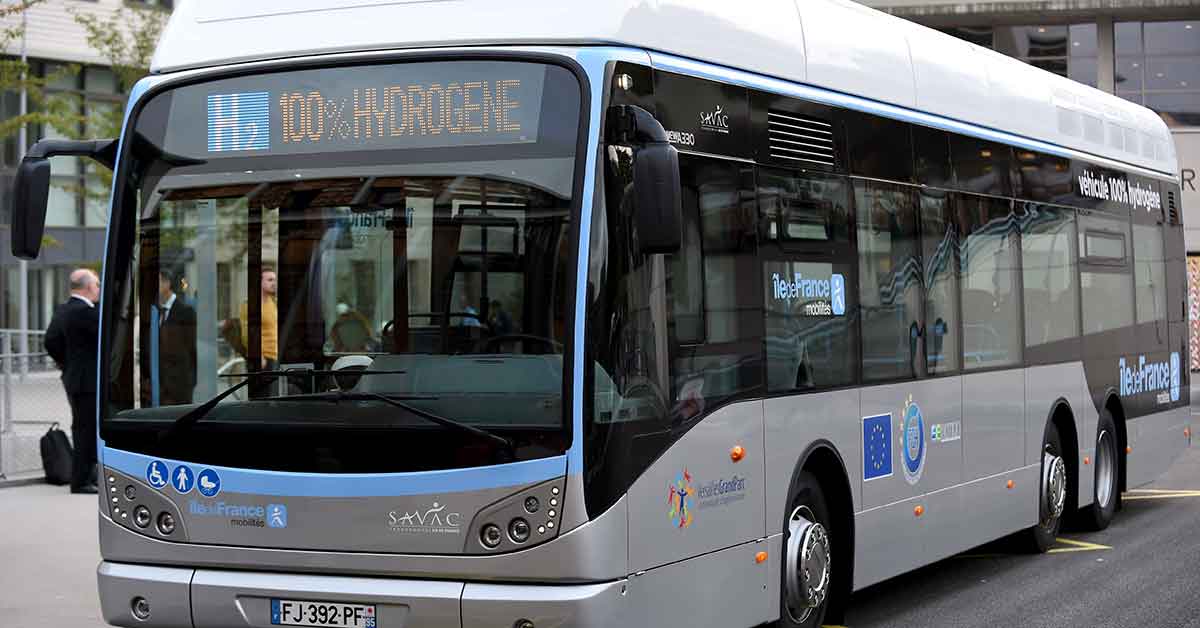According to the International Energy Agency (IEA), ASEAN currently consumes 4.5 million barrels of oil per day, while it only produces 2.5 million barrels per day, with the remaining supply gap – over 40 percent of the demand – coming from imports. Such oil demand is mainly driven by the transport sector, especially land transport, according to a research paper by the Economic Research Institute for ASEAN and East Asia (ERIA). Importing fossil fuel not only increases insecurity of energy supply, but also burdens ASEAN’s financial and fiscal systems. Greenhouse gas (GHG) emissions and urban air quality issues add further to the concerns about the reliance on fossil fuel to power transport, regardless if it is pumped from local wells or wells in the Middle East. While ASEAN has emphasised biofuels as a form of relief to this problem, the amount that liquid fuels can be blended with biofuels is limited. Currently, the most aggressive plan is to reach 20 percent of blending of biofuels.
Electrifying road vehicle fleets seems to be the most desirable path to addressing energy security, financial and fiscal burdens, and emissions and pollution challenges. European countries as well as China have already announced their target years for banning the sales of fossil fuel-powered cars. Chinese cities also compete with one another to be the first to deploy electric cars and buses for public transportation. However, it should be noted that the concept of battery electric vehicles (BEV) comes with intrinsic limitations. Issues with costs, energy density, and short lifetime of batteries are just the tip of the iceberg. Various studies have shown that if electricity is not generated by energy sources that are sufficiently clean and green, BEV will cause more emissions and pollution than fossil fuel-powered vehicles. Last but not least, we will soon face problems stemming from limited global reserves of key battery manufacturing materials and the recycling of a million tonnes of used batteries.
Another pathway to electrify road transport
The concept of hydrogen plus fuel cell electric vehicles offers another option as a complementary solution towards electrifying the road transport sector. Hydrogen has long been widely applied as a material input by a range of industries including chemical, metals, food-processing and medicine. Therefore, it is conventionally available as a by-product of many industrial processes. However, until now, hydrogen has rarely been perceived as an everyday source of energy. Even fewer people are aware of its potential as a clean and even zero-emission energy when hydrogen is completely produced from renewables.
Hydrogen also has intrinsic advantages. First, its energy intensity is higher than that of gasoline. Five kilograms of hydrogen can sustain driving up to 500 kilometres. Second, refuelling can be done as quickly as with gasoline and diesel. These two advantages make it especially suitable for long-distance or heavy-duty trips, such as intercity buses and cargo delivery by trucks. Third, hydrogen can be produced by various means, especially from clean and locally available sources such as solar, wind, hydropower, nuclear energy, and biomass. Fourth, hydrogen storage is flexible in terms of scale, location, and timing. It complements intermittent as well as seasonal renewable energy such as solar, wind, and biomass. Integrating hydrogen as part of the energy system could strategically enhance its flexibility and security.
Hydrogen economy in ASEAN
ASEAN has rich energy resources which can be mobilised to supply hydrogen and to power the transport sector by applying fuel cell technologies. According to a report by the ASEAN Centre for Energy, ASEAN has rich fossil energy reserves, including 17 billion tonnes of hard coal, 11 billion tonnes of lignite, 6.8 trillion cubic metres of natural gas, and 2.1 billion tonnes of crude oil. Using data from the BP statistical review of energy, coal production can be sustained for over half a century, assuming current levels of production in ASEAN countries. In the case of natural gas, sustained production can last for over 20 years in Brunei, over 30 years in Malaysia, over 40 years in Indonesia, and over 60 years in Vietnam.
When it comes to renewable energy, according to estimations from various reports, ASEAN possesses 229 gigawatts (GW) of theoretical resources of wind energy, 158 GW of hydropower (including small hydro), 61 GW of biomass, and 200 GW of geothermal. In regard to solar energy, ASEAN plans to install 55 GW by 2025, while Indonesia alone is predicted to develop 47 GW of capacity by 2030, according to IRENA. An ADB report indicated 8 GW of technical potential in Cambodia, while the International Renewable Energy Agency (IRENA) indicated over 10 GW of potential for Lao PDR and over 25 GW in the case of Vietnam.

However, the hydrogen supply chain and related technologies are still expensive. According to a recent ERIA study, in ASEAN, the total cost of owning and driving a hydrogen-powered fuel cell vehicle is two to three times as high as a conventional gasoline or diesel vehicle, depending on the vehicle fleet (passenger vehicle, bus, or truck), scenario of vehicle usage, and pathway of hydrogen supply.
Coupling renewable energy development and hydrogen
In line with mainstream projections about future development of hydrogen-related technologies as well as the learning effect and economy-of-scale to be achieved by the industry, ERIA’s study revealed that by around 2030, the gap in price between conventional vehicles and hydrogen-powered vehicles will largely be bridged. Policies to encourage low emission vehicles, pricing GHG emissions, or putting surcharges on conventional vehicles and fossil fuels will further add to the competitiveness of hydrogen and fuel cell electric vehicles (FCEV). This is probably why major economies are moving quickly to demonstrate, and even to adopt in commercial applications, hydrogen as an energy source. It is thus about time for ASEAN countries to seriously consider it.
Moreover, ASEAN is also currently on a firm course to achieve 23 percent renewable energy integration into its energy system by 2025, and even more by 2030. If anyone has a doubt how ASEAN’s energy infrastructure should be developed to cater for such a major transition, hydrogen-based and electrified road transport appears to be an emerging and increasingly promising option.
Yanfei Li is the Energy Economist and Policy Fellow at the Economic Research Institute for ASEAN and East Asia (ERIA). The views expressed here are personal and do not reflect ERIA’s position.
Related articles:
